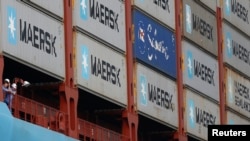Marine shipping has declined worldwide along with shaky consumer demand. Less freight naturally means more idle shipping containers that carry goods from ports to markets. In one of Asia’s older shipping hubs, Taiwan, people are finding practical and even artistic new uses for the unused steel crates.
The number of parked container ships worldwide rose sharply in November to a five-year record. The industry publication International Shipping News says idle ships account for nearly five percent of the world’s fleet due to slow demand and overcapacity. But in Kaohsiung, the major port city in shipping-intensive Taiwan, mothballed (unused) containers have moved inland. They have sprouted windows, doors, balconies and even bars that serve beer.
Taiwanese are literally moving into some of the old containers. Some have been converted to roadside stands or farm offices. A few function as suburban homes. A restaurant and a political campaign office use seven containers apiece. And the city of Kaohsiung put eight structures on display at a container art festival in December.
Taiwan architect Lin Chih-feng said modern Taiwanese like containers for their novelty value and structural flexibility.
Little by little, container structures are attracting people's attention. Lin said people are finding that they are unusual and easy to use for construction. A third draw is their convertibility, he said, and that one can move them around.
Containers might move first to the numerous stacks alongside expressways in Kaohsiung. They are either idle or too dented and rusted to be seaworthy. At Yu-Feng Container Enterprise Co., where boxes are piled up to seven levels, the management has built a side business rehabbing them for homes and sales offices. The firm that normally earns its keep storing containers now gets 30 percent of its business from conversions, which start at about $1,000 per job.
Yu-Feng manager Natasha Lee said retrofitting can be done fast. She speaks from her partitioned, air-conditioned and furnished office built from six containers.
Lee said it takes just one day to nail down a wooden floor and make space for electrical wiring in a normal small container. She adds that the trend has been quite popular recently because Taiwanese have taken a liking to artistic style, so they add architectural features to their containers.
Taiwanese officials keep no statistics on how many structures are built from containers, but they are easy to find. On a road north of Kaohsiung about 60 houses and offices occupy containers. A showroom for new housing in Taipei was built from 35 containers. Some structures are two or three levels high. The swanky, two-floor sit-down restaurant in Kaohsiung includes a dining hall, a bar and an outdoor patio.
Original corrugated steel on the containers, which are up to about 12 meters long, still shows through even on the most elaborately decorated, brightly painted structures.
Kaohsiung's city government has held a container art festival every two years since 2000. Those events have been credited for raising public interest in trying out containers for themselves. Kaohsiung has been keen over the past decade to cut dependency on manufacturing and veer into cultural enterprises.
One of container architecture's chief champions is city councilman Wu Yi-chung. He hopes citizens see them as art forms and environmentally friendly alternatives to permanent buildings that leave a footprint on the Earth.
Wu said some buildings last 100, 200 or 500 years, but that others, once they're not needed, can be moved and therefore won't cause permanent environmental damage. Wu added that by having the container art festivals, people are encouraged to use these structures and reflect on their ecological significance.
Wu speaks from a compound that he commissioned last year using seven containers. The third floor of the brightly painted structure includes a hostel room big enough for four people. Verandas on the site are big enough for chatting over coffee and watching films. A Taiwan presidential candidate, James Soong, is using the structure now to help run his campaign.








